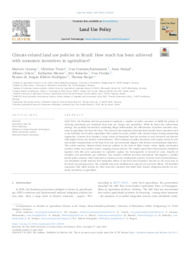Climate-related land use policies in Brazil: how much has been achieved with economic incentives in agriculture?
Climate-related land use policies in Brazil: how much has been achieved with economic incentives in agriculture?
Autoria: CARAUTA, M.; TROOST, C.; GUZMAN-BUSTAMANTE, I.; HAMPF, A.; LIBERA, A.; MEURER, K; BONECK, E.; FRANKO, U.; RODRIGUES, R. de A. R.; BERGER, T.
Resumo: Until 2019, the Brazilian federal government employed a number of policy measures to fulfill the pledge of reducing greenhouse gas emissions from land use change and agriculture. While its forest law enforcement strategy was partially successful in combating illegal deforestation, the effectiveness of positive incentive measures in agriculture has been less clear. The reason is that emissions reduction from market-based incentives such as the Brazilian Low-Carbon Agriculture Plan cannot be easily verified with current remote sensing monitoring approaches. Farmers have adopted a large variety of integrated land-use systems of crop, livestock and forestry with highly diverse per-hectare carbon balances. Their responses to policy incentives were largely driven by cost and benefit considerations at the farm level and not necessarily aligned with federal environmental objectives. This article analyzes climate-related land-use policies in the state of Mato Grosso, where highly mechanized soybean-cotton and soybean-maize cropping systems prevail. We employ agent-based bioeconomic simulation together with life-cycle assessment to explicitly capture the heterogeneity of farm-level costs, benefits of adoption, and greenhouse gas emissions. Our analysis confirms previous assessments but suggests a smaller farmer policy response when measured as increase in area of integrated systems. In terms of net carbon balances, our simulation results indicate that mitigation effects at the farm level depended heavily on the exact type of livestock and grazing system. The available data were insufficient to rule out even adverse effects. The Brazilian experience thus offers lessons for other land-rich countries that build their climate mitigation policies on economic incentives in agriculture.
Ano de publicação: 2021
Tipo de publicação: Artigo de periódico
Unidade: Embrapa Solos
Palavras-chave: Agricultural land use, Análise de incerteza do modelo, Clima, Computação de alto desempenho, Diffusion of climate-friendly technologies, Difusão de Tecnologia, Difusão de tecnologias favoráveis ao clima, Financiamento Verde, Green financing, High-performance computing, Model uncertainty analysis, Uso da Terra, Uso de terras agrícolas
Observações
1 - Por padrão são exibidas publicações dos últimos 20 anos. Para encontrar publicações mais antigas, configure o filtro ano de publicação, colocando o ano a partir do qual você deseja encontrar publicações. O filtro está na coluna da esquerda na busca acima.
2 - Para ler algumas publicações da Embrapa (apenas as que estão em formato ePub), é necessário ter, no celular ou computador, um desses softwares gratuitos. Sistemas Android: Google Play Livros; IOS: iBooks; Windows e Linux: software Calibre.
Acesse outras publicações
Acesse a Base de Dados da Pesquisa Agropecuária (BDPA) para consultar o acervo completo das bibliotecas da Embrapa.

